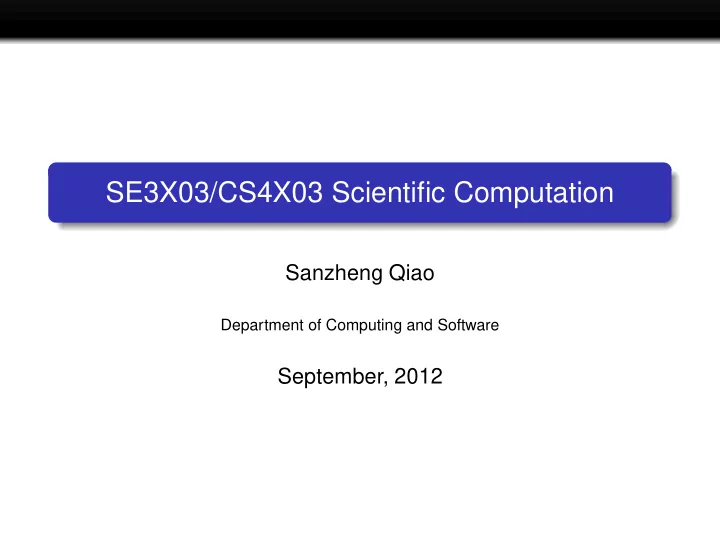

SE3X03/CS4X03 Scientific Computation Sanzheng Qiao Department of Computing and Software September, 2012
Course web page My home page: www.cas.mcmaster.ca/ ˜ qiao announcements my address, office hours TA emails lecture notes, no text book, references for each chapter assignments, penalties for late assignments last year’s exams
About this course Computer methods for solving problems in scientific and engineering applications. Evaluation scheme Four written/programming assignments 28% Midterm (closed book, 50 min) 20% Final (open book, 2 hrs) 52% Missing assignments may be combined with later assignments (not exams) A deferred midterm will be offered
Example The propagation of sound under water. The speed of sound in ocean water depends on pressure, temperature, and salinity, all of which vary with depth in fairly complicated ways. Problem: A sound source at a depth of 2000 feet transmits to a receiver 24 miles away at a depth of 3000 feet. At what angle(s) the ray leaving at the source will reach the receiver?
Example Since the sound speed varies with depth, sound rays will travel in curved paths. The effect is continuous version of the familiar refraction of light waves caused by the air-water interface in a fish bowl. The basic equation is a continuous version of Snell’s law: cos θ c ( z ) = constant . where z denotes the depth of a particular ray at distance x , ( z is a function of x ), c ( z ) is the speed of sound at depth z , and θ = θ ( x ) denote the angle between a horizontal line and the tagent to the ray at x , i.e., tan θ = dz dx .
Example These two equations together yield a second order ordinary differential equation d 2 z dx 2 = − c ′ ( z ) A 2 c ( z ) 3 , where A is the constant occurring in Snell’s law. This second order differential equation is then transformed into a system of two first order equations.
Example Problem: Solving a system of two first order ordinary differential equations with initial conditions: the depth of the source z ( 0 ) the ray angle at the source Requires c ( z ) , speed at depth z used in the solver.
Example Measure the speed of sound at various depths: depth z 0 500 1000 · · · 11000 12000 speed c ( z ) 5042 4995 4948 · · · 4973 4991 The ODE solver requires c ( z ) at depths other than those depths.
Example Problems: Construct a function that interpolates the measurements, for example, c ( 0 ) = 5042, c ( 500 ) = 4995. But it can be evaluates at any value of z between 0 and 12,000, such as z ( 780 ) . 5060 5040 5020 5000 4980 speed (ft/sec) 4960 4940 4920 4900 4880 4860 0 2000 4000 6000 8000 10000 12000 depth (ft) Constructing an interpolation function requires solving a system of linear equations.
Example For a given initial angle at source, by solving the differential equation (involving the evaluation of an interpolation function), we obtain the depth of the ray 24 miles away. We want to find the initial angle(s) so that the depth is 3000 feet. Problem: Solving a nonlinear equation f ( θ 0 ) − 3000 = 0, where f represents the above quite complicated process and θ 0 the initial angle.
Text book formulas vs computer methods Solving a quadratic equation ax 2 + bx + c = 0 , a � = 0 Text book formula: √ √ x 1 = − b + b 2 − 4 ac x 2 = − b − b 2 − 4 ac , 2 a 2 a Computer method: 2 c c x 1 = x 2 = √ , ax 1 − b − sign ( b ) b 2 − 4 ac Mathematically equivalent, but more efficient, more accurate, and more robust.
Real vs floating-point Math formulas use real variables, whereas computer programs use floating-point variables (float, double). Floating-point numbers (finite precision) are approximations of real numbers (continuous). We will first discuss the differences between real numbers and floating-point numbers. The implications of finite precision.
Suggestions Attend lectures and tutorials (no text book, skipping lectures can be costly, instead of saving you time) Review lectures regularly, at least once a week (easier when it is still fresh, for the same reason, deferred exam is harder for you) Work independently (helps you understand the details) Get help whenever it is needed, office hours, tutorials, appointments (more efficient) Maximizing your time!
Let’s work together. Good luck!
Recommend
More recommend